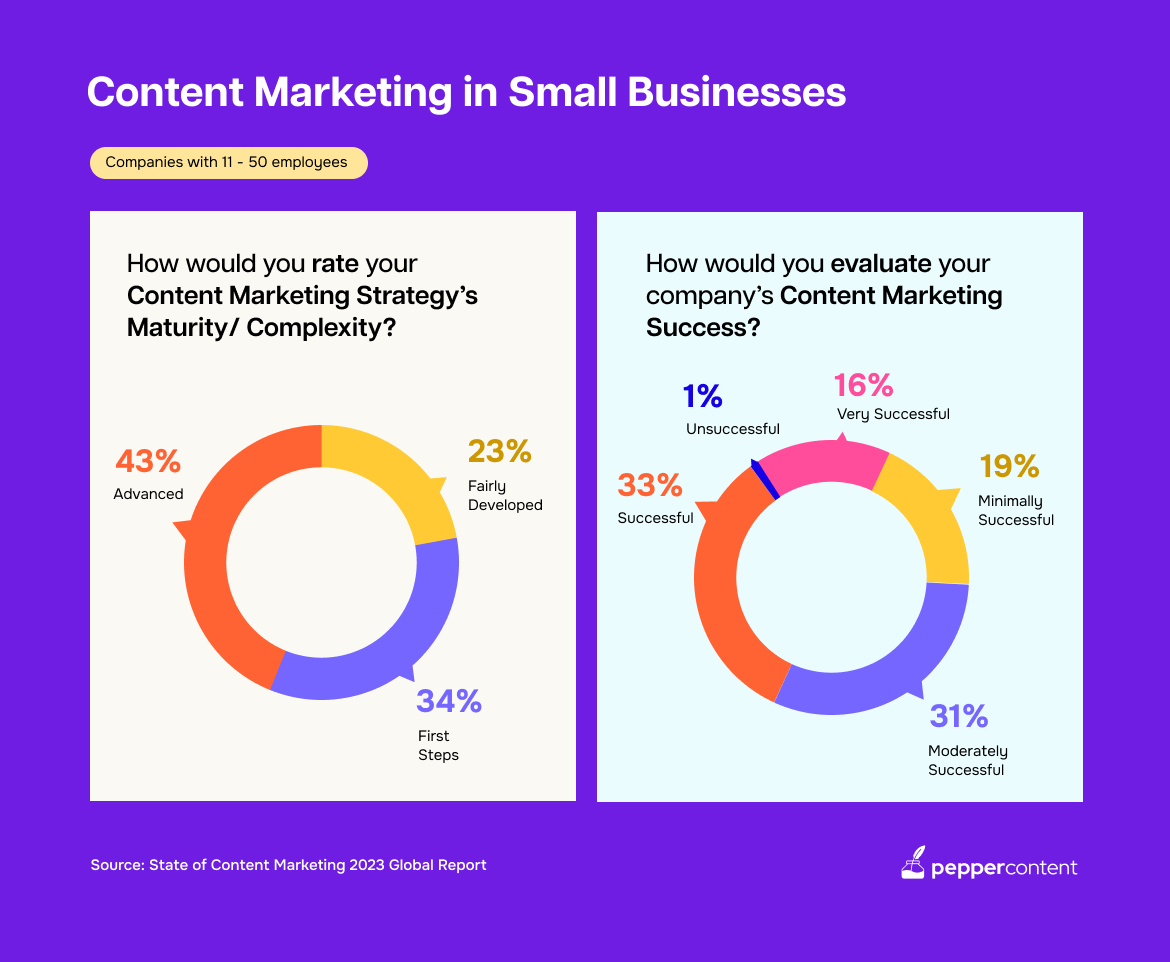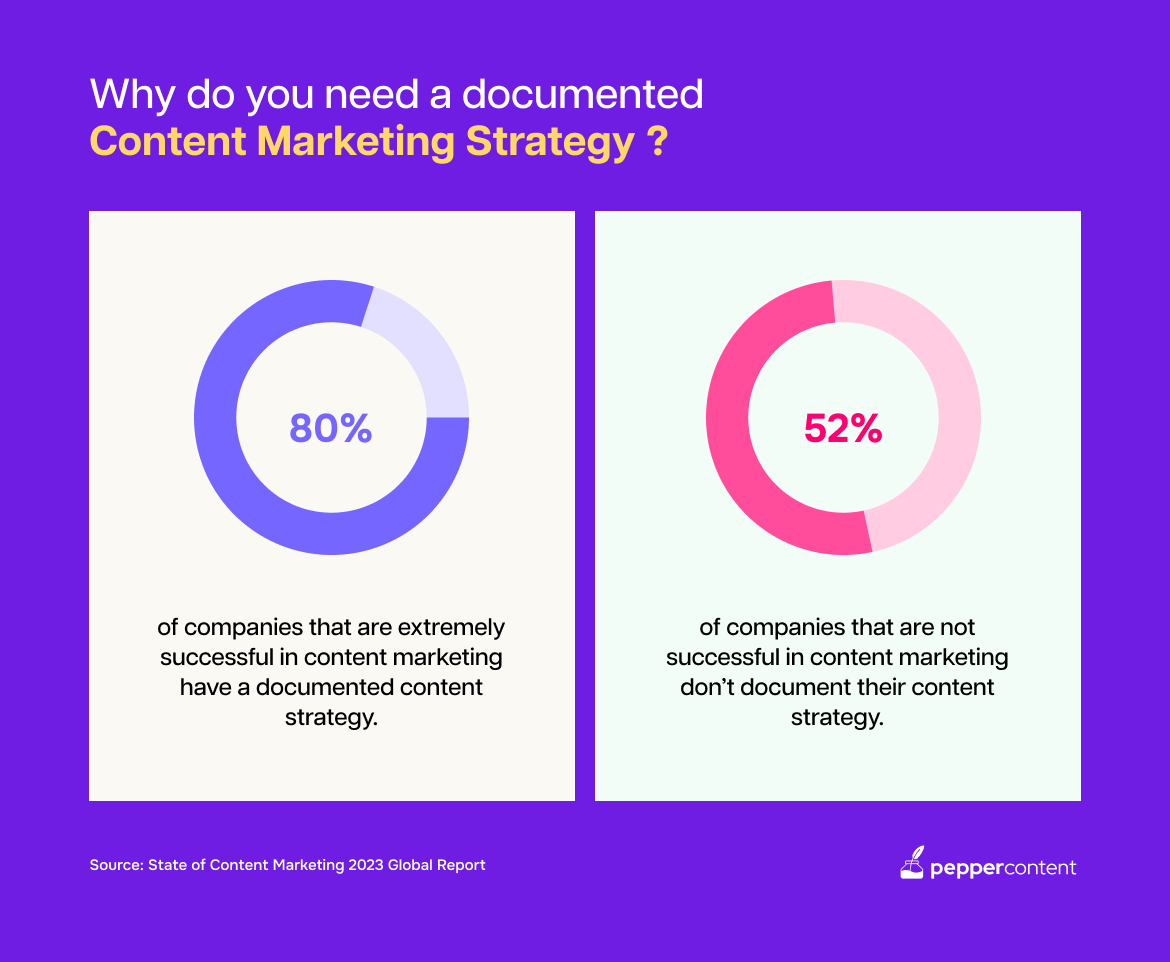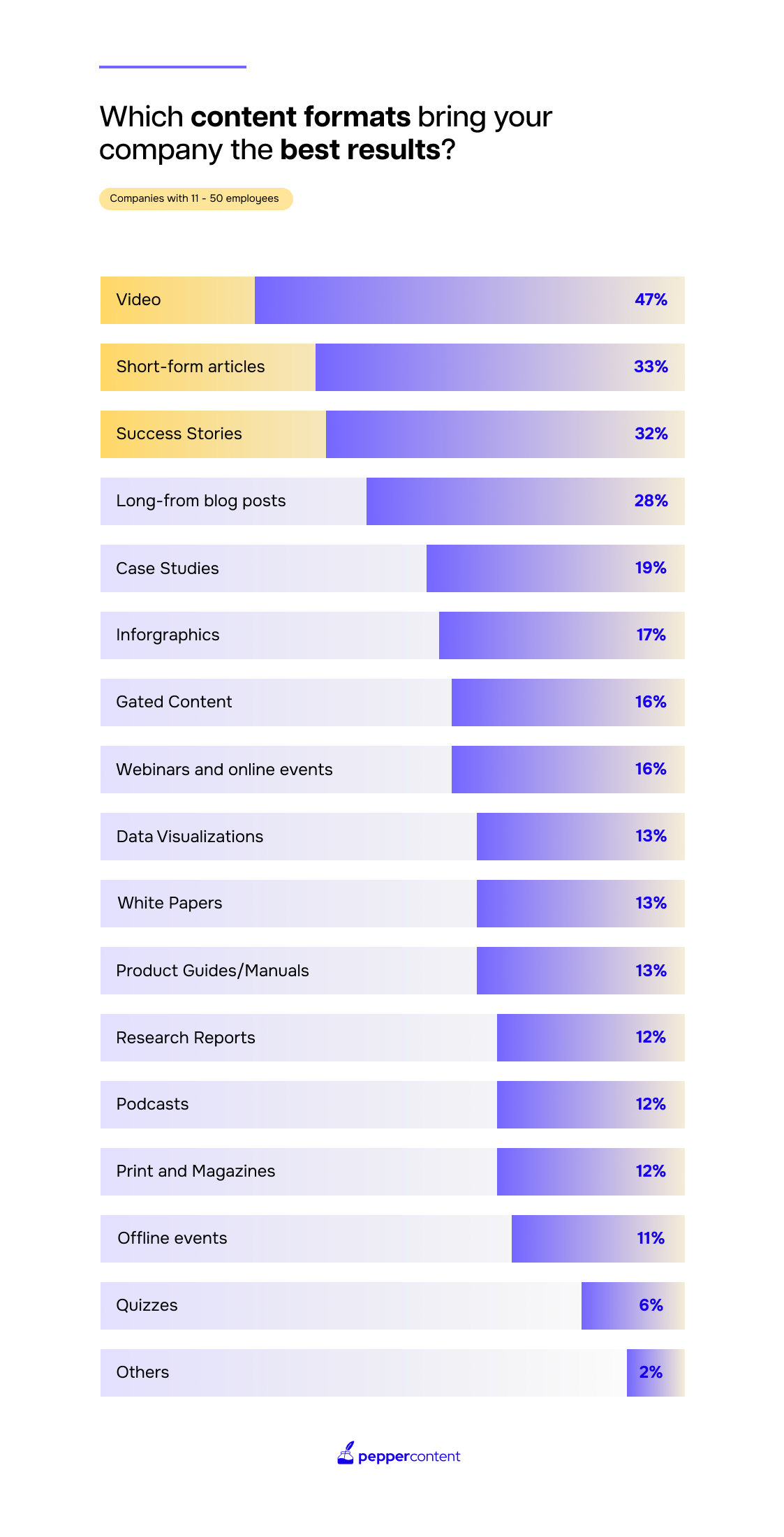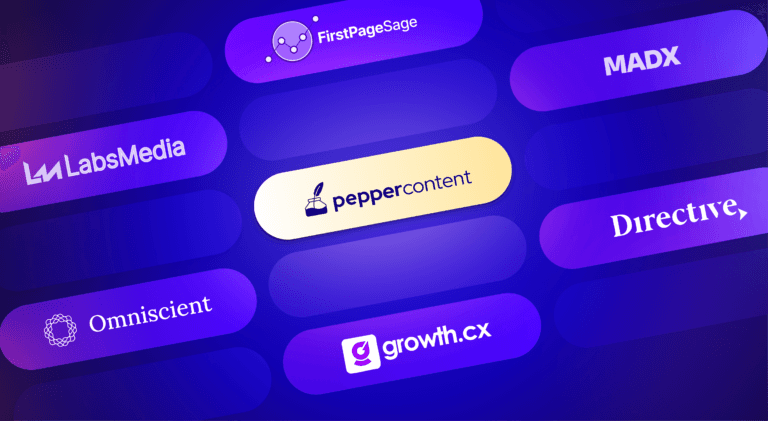How to Create a Local Content Marketing Strategy for Your Business

Content marketing has become one of the most effective ways that most businesses and marketers leverage to reach their target audience, as high-quality content drives the success of SEO campaigns. While big organizations and brands initially used content marketing campaigns, the strategy has now become more accessible and affordable to local businesses and entrepreneurs. Moreover, it has been democratized, allowing businesses of all sizes to compete with larger corporations.
SEMrush’s State of Content Marketing 2023 Global Report suggests that 99% of businesses with 11-50 employees, both online and offline, are witnessing significant success with content marketing. Additionally, 66% have a well-developed or highly advanced content strategy.

Content marketing plays a more prominent role than ever in improving your local search presence and establishing trust in the market. It lets customers learn about your local business and judge its authenticity. But, to achieve these results, you have to create a local content marketing strategy that makes your business stand out.
So, what does content marketing for local businesses look like? Let’s get started!
How to Build a Local Business Content Marketing Strategy
Many businesses consider that having a content strategy means just creating a certain number of new pieces each week. But that’s not the whole story. Simply publishing content without a proper goal won’t lead to effective marketing. Simultaneously, companies that don’t document their content marketing strategy aren’t successful in their marketing efforts.

Creating a successful strategy involves carefully planning, analyzing, and trying different approaches.
The great thing is, not many businesses are taking full advantage of content marketing localization. This means there’s a good chance for small businesses to really shine. Local content can come in different forms, like informative blogs, eye-catching infographics, helpful guides, videos, etc. Below are the steps you can implement to create a successful localized content marketing strategy for your business.
Understanding the Local Audience
Content Creation
Content Distribution
Performance Measurement
Let’s dive deeper into it!
Step 1: Understanding the Local Audience
Before you start creating localized content campaigns, you need to understand the target audience you’re aiming to hit. Research their preferences, pain points, and online behavior to gain a better understanding. When you know your audience well, you can create a content marketing strategy that resonates with local cultural nuances and regional trends.
But how do you get to know the local audience better? Here’s how:
Create Customer Personas: This means creating profiles that represent your ideal customers. You do this by looking at actual customer info and finding commonalities in their locations, goals, behavior, etc.
Conduct Market Research: You can leverage tools such as Google Trends to see what’s trending in your local market.
See What Your Competitors Are Doing: Look at what other local businesses in your niche are up to and what is catching their audience’s attention.
Focus On Customer Engagement: Ask your current customers what they like about your business and what they want to see more of.
Leverage Social Media Analytics: If you actively use platforms such as Facebook or Instagram, you can use their inbuilt tools to get insights into your audience’s age, interests, and behavior. On the other hand, you can get valuable insights regarding audience demographics from your YouTube Analytics dashboard.
One great example of this is KFC’s marketing campaign in South Africa, wherein the company launched limited-edition buckets featuring the illustrations of Karabo Poppy. This endeavor encouraged customers to click photographs and post on social platforms using the hashtag #madeforsharing. It’s similar to how the brand sold limited-edition holiday-themed buckets during Christmas in the US. KFC not only learned how to cater to different tastes around the world but also did an excellent job at understanding and reaching its target audience through localized marketing.

Step 2: Content Creation
Your business can use its local content strategy as a powerful tool to stand out. Start by diving deep into your own content and what your competitors are putting out. Figure out what’s connecting with audiences and what’s not. Once you’ve got a good idea of what your competitors are targeting, aim to recreate that success with your upcoming content.
Be creative. For example, you can turn your latest blog post into an eye-catching infographic. Or, you can transform that infographic into a detailed whitepaper. You could even take that whitepaper and turn it into a series of shareable social media posts with insightful quotes.
The possibilities for creating content are pretty much endless.However, if you do not have the bandwidth or expertise to craft high-quality content, you can outsource your content creation with Pepper Content writing services.

Once you’ve created the content, focus on local SEO and keyword optimization. In this case, you can use keywords relevant to the particular region you’re targeting, including city and state names and local landmarks. Additionally, ensure your Google My Business profile is complete and includes the correct business category, operating hours, location, and contact information.
Remember, it’s not the quantity of content you produce but the quality of content you publish that matters.
Step 3: Content Distribution
Once you’ve made content for your website and local platforms, it’s time to distribute it on social media platforms, as it’s a powerful tool for connecting with your local crowd and promoting your business.
Here are some strategies for making the most of our social media platform for localized content sharing:
Publish content on your own social media accounts, including Facebook, Instagram, X (formerly Twitter), or TikTok.
Maintain a regular posting schedule.
Don’t forget to add links to your content and insert captivating pictures or videos to grab your followers’ interest.
Use location-specific hashtags in your posts.
Use geo-targeting options provided by these platforms.
Offer special deals or promotions exclusively to local followers.
Encourage your local customers to create content related to your business or products.
Engage with comments, messages, and reviews from local users promptly. This shows that you value their input.
You can also build relationships with local influencers, organizations, and businesses to acquire backlinks from authoritative local sources for broader audience reach. Moreover, you can also create tailored email marketing campaigns to engage with your local audience and build brand awareness effectively.
Step 4: Performance Measurement
Last but not least, create a plan for measuring the performance of your content in your strategy document. Here are some of the metrics you should focus on:
Referral Rates
Organic and Inorganic Page Views
Number of Downloads
Revenue Generation
Lead Generation
Conversion Rates
Make sure the KPIs align with the end goal of your local content marketing strategy. Once you figure out what works well with your audience, make adjustments and changes accordingly.
Case Study Example: A Deeper Dive
Seed, a brand that specializes in probiotics, took a fresh and unique approach to its content and social media marketing right from the start.

Their mission is all about spreading knowledge about probiotics and health using a scientific approach. They’re not afraid to dive into any subject and consistently share informative content. Additionally, they’ve crafted a unique visual identity and tone of voice (TOV) that sets them apart from competitors in their field. You can see their uniqueness in using content to educate their audience in the above snapshot.
Key Takeaways
A successful content marketing strategy is more than just publishing content. It involves personalizing content to cater to your audience’s needs, staying updated with the latest trends, and using different content formats to maintain variety and interest. Moreover, it means posting content regularly and leveraging the right platforms for distribution.
To create an effective content marketing strategy, you must better understand your local audience, their needs, and the content they consume.
Search engine optimization (SEO) is essential to a local content marketing strategy. It means using targeted keywords in your content that people often search for. This helps search engines like Google find your content when someone is looking for information.
Build relationships with local influencers, organizations, and businesses to acquire backlinks from authoritative local sources for broader audience reach.
A content marketing strategy aims to build brand awareness and increase customer engagement.
Your Checklist For Creating Local Content Marketing Strategy for Your Business
For local businesses to succeed in today’s competitive world, they must prioritize content marketing. This means creating valuable, engaging content that speaks directly to their local audience. By doing this, local businesses can become experts in their industry, increase visibility, attract more visitors without paid ads, build strong relationships with customers, and achieve steady growth.
Here are some of the actionable steps to kickstart their local content marketing journey:
Know Your Audience: Understand your local audience’s interests, pain points, and preferences.
Keyword Research: Use local keywords relevant to your area to improve search visibility.
Create Localized Content: Develop content tailored specifically for your local audience.
Leverage Local SEO: Optimize your content for local search results, including Google My Business.
Utilize Local Hashtags: Incorporate local hashtags in your social media posts.
Engage with Local Influencers: Collaborate with influencers with a strong local presence.
Showcase Local Testimonials: Highlight reviews and testimonials from local customers.
Promote Local Events: Cover and promote local events or happenings related to your industry.
Geo-Targeted Advertising: Use advertising features to target specific local areas.
Monitor Local Trends: Stay updated on local news and trends to create relevant content.
Conclusion
Implementing a successful local content marketing strategy requires an in-depth understanding of the target audience, creating unique and relevant content, and a willingness to adjust and improve based on performance metrics. But when local businesses dive into content marketing, they secure a strong foothold and stay ahead of their local competitors!

Latest Blogs
Learn how to rank on AI search engines like ChatGPT, Perplexity, and Gemini by optimizing your content for authority, structure, and relevance. Stay ahead in AI-driven search with this strategic guide.
Explore the best healthcare SEO services for your medical practice. Improve online visibility and effectively reach more patients in need of your services.
Discover top social media agencies specializing in banking solutions, enhancing financial services and driving engagement.
Get your hands on the latest news!
Similar Posts

Content Strategy
5 mins read
Choosing The Best Healthcare Marketing Agency For Effective Content Solutions

Content Marketing
4 mins read
Top 10 Agencies B2B SaaS Content Marketing for B2B Success

B2C Marketing
5 mins read